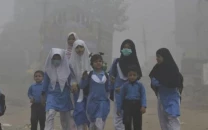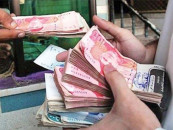Motorcycle diaries
Someone has to take the initiative and encourage the practice of women riding bicycles in Pakistan.

Motorcycle diaries
She steps out of her dusty lane and walks arduously to the bus stop, a little envious of the people hurrying into the lined up rickshaws on the sides of the roads. She shuffles up behind an uneven line of women at the bus stop as she waits for her bus to get her to work. She calculates the number of men who are bunched up front, more agile, expectant and anxious. She is wondering if the few minutes the bus will stop to pick up passengers will be enough for her to grab on to the rungs and haul herself up, or if the wave of belligerent men will force her to the periphery of the crowd. Next to her is a young college student, her eyes as expectant and hopeful as hers. Both have eyes transfixed on the looming bus, both wondering if luck and time are on their side.
These women are just two of the millions of women in Pakistan who rely daily on public transport to sustain their lives and achieve the goals that they set out to do. And they are considered to be the lucky ones because they are allowed to mingle in society and take public transport to go out into the world with respect and dignity. Yet, of the millions of women who belong to lower income urban households, who hold jobs, attend colleges, may even be teachers, lawyers, nurses, saleswomen and even the primary breadwinners of their families, not one of them could ever consider owning their own independent transport!
Of course, your mind jumps to the four-wheeled gas guzzling luxury of a car and your next thought is the expense of it but independent transport comes in other forms, too. It is visible on the street at all times. Look around and you will spot the cheapest independent means of transport, the bicycle. Bicycles are available at a cost of a mere Rs2,000. In fact, bicycles in Asia alone transport more people than all the world's cars! There's a bridge in Guangzhou (Canton), China that serves as the main artery over the Zhujian River. It has three narrow lanes in the center for motorised transport and on either side are bicycle lanes that provide almost twice the width available to the cars and buses! During the rush hours in Asia, bicycles account for two-thirds of all vehicles on the road.
Then there are scooters and motorcycles which are another very affordable independent mode of transportation. Surprisingly, in 21st century Pakistan where the middle class urban household has most of its women either studying, working and contributing as active homemakers, there is no sign of a woman owning a two wheeler, the primary means of transport in most developing countries. Moreover, the households that these women come from probably have male members who use a bicycle or a motorcycle but a woman cannot even consider operating a two wheeler in Pakistan even if her life depended on it.
And so heads nod and shake in unison at the absurdity of a Pakistani woman sitting astride on a motorcycle or a bicycle. I found a photograph of a Pakistani woman driving another woman on a motorcycle on the internet and I was delighted. A quick glance at the website and I was duly admonished because it was a site highlighting the ridiculous sights in Pakistan. I know that there is a Pakistan women’s cyclist team which competes internationally and has won medals and all and Pakistan is very proud of them. There is no law in Pakistan that states that women cannot own or ride a two wheeler. Women car drivers are as apparent as male drivers on the streets of all major cities. Well, what happened to Pakistan and the cycle revolution?
Let’s talk about practical growing developing countries like Malaysia and Indonesia which, like Pakistan, are predominantly Muslim. Women cycling, clad in hijab, in these countries is a common occurrence. I Googled cycling and women on Islamic forums and they all seem to have no issue with the practice as long as the women are properly covered. In fact, one of the websites even talked about special hijabs available for women sewn in just the right way, so that nothing is exposed even if the foulest wind crosses the unsuspecting women cyclist. This practice of women shying away from cycling is also found in rural India. Unlike the cities, where women have been freely cycling and sitting astride safely on motorbikes for decades, cultural taboos still exist in rural areas.
The story of the introduction of bicycles and bicycle riding skills as part of a literacy campaign by the National Literacy Mission in the early 1990s in the Pudukkottai region of Tamil Nadu is a well-known example of women’s increased mobility, independence and empowerment through the successful implementation of the bicycle.
The initial campaign enlisted the help of men to teach women how to cycle. Loans were made available for women to buy bicycles and those with a regular income, such as NGO workers, were quick to take these up. As more women were seen cycling regularly, the opposition and male jokes died away. It became acceptable through the sense of it being a widespread movement. Even riding a gentleman’s bicycle in a sari did not bother the women anymore –– the convenience of the mode of transport outweighed all other considerations.
Women from poorer families face fewer restrictions on their mobility than do more well-to-do women, whose families are more concerned with maintaining the family’s izzat (respectability and honor). There are several examples of poor women who have been driven by economic circumstances to challenge social and religious conventions and become more mobile. Changing perceptions of bicycles as a ‘modern’ means of transport has meant that women riding bicycles in many countries like Nepal and Sri Lanka are considered desirable wives. It may seem a far possibility but someone has to take the initiative and encourage the practice in Pakistan.
There is a bicycle club in Karachi with women and men who take to the streets every weekend and expose the men on the streets of Karachi to women on a two wheeler. It is aptly called Critical Mass. And maybe that is really what we need; a ‘critical mass’ of women challenging conventions. It is a well known fact that a critical mass can effect changes in social and cultural attitudes.
At least that is a start, but the practical aspects of women and the ownership and operation of an affordable, independent means of transport should be a priority for a country like Pakistan which seems to overcome taboos in behaviour quite well given an exposure to a practical, economically-viable option. Mass media advertising could include women on motorbikes sitting the safer way rather than side-saddle, about to fly off on the next road bump. Women cycling, women on a motorcycle, women on a scooter; the possibilities are endless. We just have to get the populace used to it. It would benefit so many women in Pakistan.
So imagine Nishat Bibi, who may be too old and too set in her ways, to learn how to ride a bike, buying her young granddaughter a moped. The young girl could drop her to work every morning on her way to college and pick her up in the evening and they could do their groceries on the way back, too, saving Nishat Bibi the two hour commute in the morning and back and giving her more time to concentrate on the small clothing business she runs from her home. That is a future worth speaking up for and a dream worth turning into a near possibility!
Published in The Express Tribune, April 20th, 2012.














COMMENTS
Comments are moderated and generally will be posted if they are on-topic and not abusive.
For more information, please see our Comments FAQ